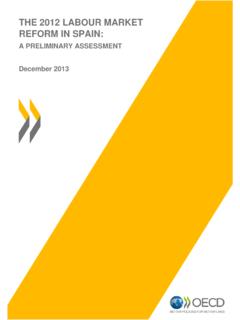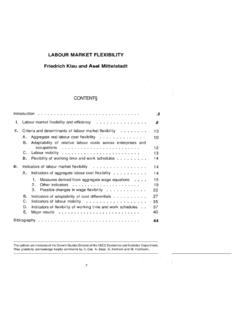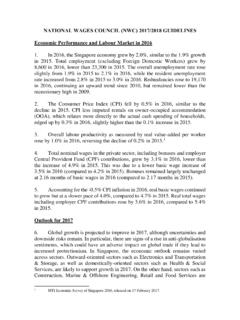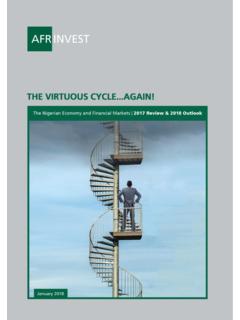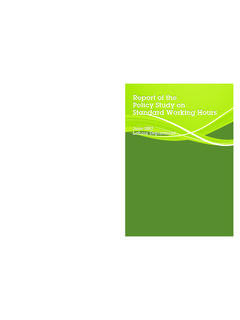Transcription of Contents
1 Contents IHD Team for the india labour and employment report 2014 Abbreviations List of Tables, Figures and Boxes 1. labour in Globalizing india : An Overview Introduction employment , Unemployment and labour Force Dynamics Structural Changes in the Economy and employment : Growing Asymmetry Persistent Dominance of the Unorganized Sector Multiple Bases of labour Market Segmentation Wage Increase, Wage Differentials and Minimum Wag es Large Number of Working Poor : The Disconnect between Work and Income Underemployment: A Continuing Characteristic of employment labour Market Flexibility: The Noise and the Reality Increasing Informalization of employment : Challenge of Social Security labour Organizations and labour Rights: Some Disconcerting Signals Globalization and Indian labour : A Recapitulation 2. Economic Growth and employment : Performance and Emerging Challenges Introduction: Growth and employment Characteristics and Structure of the Indian labour Market Trend and Pattern of employment Growth Migration of Workers The employment Challenge Unemployment and the Challenge of the Youth Bulge Summing Up: Key Features of the employment Situation 3.
2 Access to and Exclusion from employment : Social and Regional Dimensions Introduction Historical and Geographical Profile of Socio- religious Groups in india Poverty by Socio-religious Groups and Region Access to employment by Socio-religious Group Access to employment within Socio-religious Group Regional Exclusion Regional Dimensions of Unemployment Conclusions india labour and employment report 2014 4. Wages, Earnings and Inequality Introduction Wage Patterns Other Aspects of Wage Inequality Wages, Non-wage Incomes, and Profits The Implementation of the Minimum Wages Act 1948 In Conclusion 5. labour Institutions and Industrial and employment Relations Introduction Legal Framework and labour Administration Workers Organizations in india Industrial Conflict in india Social Dialogue: Tripartism and Collective Bargaining labour Regulation and labour Reforms Conclusions 6.
3 Social Security for Workers: Issues and Challenges Issues and Concerns The Evolution of Social Security for Formal Workers Social Security for Workers in the Informal Sector The Way Forward: Steps Towards a National Minimum Universal Social Security or Social Protection Floor 7. employment Strategies, Policies and Programmes employment in Development Strategy Macroeconomic Policies and employment Sectoral Policies Targeted employment Programmes Skill Development Policy and Programmes employment and the Policy of Affirmative Action National employment Service (NES) Concluding Remarks 8. The labour and employment Agenda Today A Balance Sheet Emerging Research and Policy Agenda Conclusion References Statistical Appendix GlossaryPrincipal Author and General Editor Alakh N. Sharma, Director, Institute for Human Development and Editor, Indian Journal of labour EconomicsPrincipal Contributors and Senior Editors Papola, Hon.
4 Professor, Institute for Studies in Industrial Development and President, Indian Society of labour Economcis Research and Development Reddy, Professor, Sankaran Chair and Visiting Professor, Institute for Human Development (IHD)Background Paper WritersSant Lal Arora, Visiting Fellow, Kannan, Chairman, Laurie Baker Centre for Habitat Studies, Thiruvanthapuram and Visiting Professor, Mamgain, Professor, Giri Institute of Development Studies, Lucknow; Formerly Senior Fellow, IHDLate Ashok K. Mathur, Visiting Professor, IHDB alwant Singh Mehta, Associate Fellow, IHDDev Nathan, Professor, IHDG erry Rodgers, Visiting Professor, IHD and Former Director, International Institute for labour Studies, GenevaShreya Sarawgi, Fellow, IHDS andip Sarkar, Professor, Shyam Sundar, Professor, XLRI Xavier School of Management, JamshedpurIHD Research and Data Processing TeamSant Lal Arora, Visiting Fellow, IHDA bhishek Kumar, Research Associate, IHDB alwant Singh Mehta, Associate Fellow, IHDO verall ReviewersAjit Ghose, Honorary Professor, IHD; Formerly Senior Economist, ILOJ.
5 Krishnamurty, Visiting Professor, IHD; Former Professor, Delhi School of Economics Gerry Rodgers, Visiting Professor, IHD and Former Director, International Institute for labour Studies, Geneva IHD Team india labour and employment report 2014: HighlightsI. The Context india has witnessed an impressive GDP growth rate of over 6 per cent since the 1980s. Growth has been particularly rapid since the post-reform period of the 1990s. This high growth has contributed to a sustained increase in per capita income and a decline in absolute poverty, as well as modest improvement in standards of living. It has also brought important changes in employment conditions in the country. The structure of the labour market, patterns of employment growth, and labour -market institutions play an important role in shaping development patterns and outcomes. However, there is a lack of analytical documentation on these issues. The india labour and employment report , planned as the first of a series of periodic publications by the Institute for Human Development (IHD), aims to fill the gap.
6 The first report india labour and employment report 2014 provides analyses of the changes in the labour market and employment since the inception of economic reform. It explores the dynamics of these changes, by looking at labour -market institutions, different types of employment , and labour market policies. It also outlines the emerging agenda for policies and action that emerge from such analyses. II. labour Market and employment Conditions in india Today, india is counted among the most important emerging economies of the world but employment conditions in the country still remain poor. Overall, labour -force to population ratio (in the age group 15 years and above) at 56 per cent is low in india compared to nearly 64 per cent for the rest of the world. The low participation in india is largely because the female labour force participation rate (LFPR) is dismally low at 31 per cent, which is amongst the lowest in the world and the second lowest in South Asia after Pakistan (though official figures are clearly underestimated).
7 Even today the large proportion of workers engaged in agriculture (about 49 per cent) contribute a mere 14 per cent to the GDP. In contrast, the service sector which contributes 58 per cent of the GDP barely generates 27 per cent of the employment , and the share of manufacturing in both employment (13 per cent) and GDP (16 per cent) is much lower than in East Asian and South-East Asian countries. This unbalanced pattern of growth is at variance with not just the experience of the fast growing economies of East and South East Asia but also the economic historical experience of the present day developed countries of the West. An overwhelmingly large percentage of workers (about 92 per cent) are engaged in informal employment and a large majority of them have low earnings with limited or no social protection. This is true for a substantial proportion of workers in the organized sector as well. Over half the workers are self-employed, largely with a poor asset-base, and around 30 per cent are casual labourers seeking employment on a daily basis.
8 About 18 per cent of those employed are regular workers, and amongst them less than 8 per cent have regular, full-time employment with social protection. Levels of education and professional and vocational skills are extremely low. Less than 30 per cent of the workforce has completed secondary education or higher, and less than one-tenth have had vocational training, either formal or informal. Although these figures, based on National sample Survey Organisation (NSSO) surveys, do not capture many types of skills that are informally acquired, it still suggests that skill-acquisition is generally very low. Since good quality formal employment is rare, access to it is extremely unequal. Disadvantaged social groups such as Scheduled Castes (SCs), Scheduled Tribes (STs), and large sections of the Other Backward Classes (OBCs) are mostly concentrated in low-productivity sectors such as agriculture and construction and in low-paying jobs as casual labourers and Muslims are concentrated in petty so-called low productive self- employment .
9 On the other hand, upper-caste Hindus and others (comprising minorities such as Jains, Sikhs and Christians), have a disproportionate share of good jobs and higher educational attainments. There is an overlap between poverty and poor quality of employment as well. There is considerable regional differentiation in access to good quality employment . A preliminary employment Situation Index (ESI) prepared for this report shows that generally india labour and employment report 2014: HIgHLIgHts4 india labour AnD employment report 2014: HIGHLIGHTS workers in the southern and western states of india have much better access to good quality employment than do workers in states in the central and eastern regions. Himachal Pradesh ranks number one, in particular because of a good performance with respect to women s employment , while Bihar ranks last (see Appendix Table for details as well as indicators used in the index). There is considerable segmentation in the labour market in terms of forms of employment , sector, location, region, gender, caste, religion, tribe, etc.
10 In spite of increased mobility over the years, acute dualism and sometimes fragmentation persists in the labour market. There is a great deal of movement between places of residence and work, and rural-to-rural and rural-to-urban migration is substantial, especially in terms of circular and temporary migration. Women in general are disadvantaged in the labour market. In addition to their low share in overall employment , greater proportions of them are engaged in low-productivity, low-income, insecure jobs in farms, and in the unorganized and informal sectors as compared to men. As is typical for a poor and developing economy, most workers in india cannot afford to be unemployed, hence the level of open-unemployment is quite low at per cent. Even the more comprehensive current daily status (CDS) measure of unemployment reaches only per cent. In reality, the problem is not primarily one of unemployment but lack of productive employment . III. labour Market Performance and employment Outcomes in the Last Three DecadesLabour markets have witnessed significant changes in two decades since the economic reforms, which started in the 1990s.



